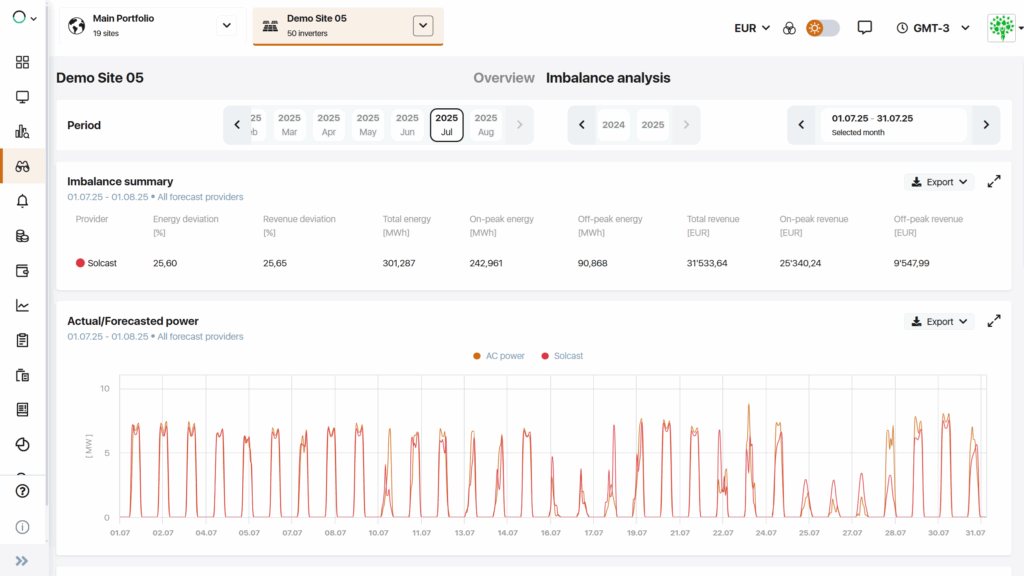How to leverage satellite data for PV projects
Performance assessment for solar PV is not as straightforward as for conventional power plants. Before measuring electrical power outputs comes the crucial step of accurately calculating the expected production. And this is why truly reliable data must be as robust as it is dynamic.
Fossil fuel plants have a clear, tangible and measurable inputs. Not so for solar plants. Their “fuel” is sunlight: immaterial, variable, and tricky to measure accurately. Add the effects of temperature and any issues with sensor reliability into the mix, and calculating expected production becomes a complex puzzle.
Weather sensors are great — when they work. Even the best hardware is not infallible: communication dropouts, calibration drift, poor maintenance, or even a misaligned installation can throw off your irradiance and temperature readings by significant margins. And let’s not forget the costs of deploying and maintaining high-quality sensors, which in most cases only makes financial sense for large assets. This is where satellite data comes into play.
Satellite data is a scalable, cost-effective alternative to deal everything from hardware outages to managing small plants without on-site sensors. Round-the-clock and up-to-date weather data ensures you’re never flying blind. Moreover, you can use the weather forecast to optimize the bidding processes for merchant projects, or to anticipate weather events and plan the operation and maintenance of your fleet.
The increased demand for renewable energy sources makes the market grow in both size and complexity. In our efforts to not simply stay ahead of the trend, but to be a driving force in the energy transition, GreenPowerMonitor, a DNV company, launched GPM Horizon Solar: a single modular platform to empower asset owners and managers to shape the future of renewable energy management.
This article explores how GPM Horizon Solar allows you to leverage satellite data to efficiently manage solar PV assets by boosting advanced analytics and improving the quality of your reporting. Our aim is to provide a clear understanding of the benefits of satellite data and its main uses cases in solar energy management.

Figure 1: GPM Horizon Solar Forecast module
Satellite live data: your always-on weather backup
For renewable asset managers, performance is everything, and it hinges on three critical signals: energy production, temperature, and irradiance. This triad is the backbone of any meaningful performance analysis. To assess how efficiently a plant operates, we compare actual production against expected generation. And to calculate the expected production, we need reliable irradiance and temperature data.
The bottom line: accurate weather data is non-negotiable. Without it, performance ratios, availability metrics and other key performance indicators lose their meaning.
Unfortunately, sensors are vulnerable to several factors that can render their data unreliable. Common culprits include:
- Communication failures, such as network dropouts or data logger issues.
- Misconfiguration (incorrect scaling factors, wrong orientation, or faulty installation).
- Poor maintenance (soiled pyranometers, detached temperature probes).
- Calibration drift over time.
A common mitigation strategy is to increase sensor redundancy, hoping that most sensors will provide consistent readings and highlight outliers. While this approach has its merits, it also introduces higher OPEX and more complex maintenance routines, but cannot guarantee 100% data availability. Thus, properly maintained ground-based sensors offer higher accuracy, but satellite-derived irradiance data excels in coverage, consistency, and uptime. And in the case of smaller sites, the cost of maintaining and recalibrating multiple sensors can quickly outweigh the benefits.
It is true that cloudy conditions may be challenging for satellite data providers, as they increase the complexity of accurate reporting with high time and spatial resolution. Even so, when averaged over time, satellite data smooths out transient cloud effects and becomes a powerful tool to guarantee 100% availability for reporting over long periods of time. What is more, when managing large and diverse portfolios, it is possible have a consistent, reliable and scalable back-up with just one provider capable of providing satellite data covering the entire geographical span of the portfolio.
An additional benefit: under clear-sky conditions, satellite irradiance can act as a reference standard (allowing for a certain level of uncertainty), flagging underperforming or misbehaving sensors. This makes it an invaluable asset for automated quality control and anomaly detection.
At GreenPowerMonitor, a DNV company we’ve engineered GPM Horizon to make the most of both worlds. Our platform is geared to:
- Prioritize on-site sensors (when available), using advanced analytics and filtering to discard incorrect data.
- Seamlessly switch to satellite data when sensors fail or are unavailable, ensuring uninterrupted reporting.
- Enable side-by-side comparisons between satellite and sensor data, offering clear, actionable insights—such as identifying the perfect moment to recalibrate, clean, or replace a sensor.
With GPM Horizon, you’re not just collecting data—you’re turning it into actionable decisions.
Beyond irradiance and temperature
While irradiance and temperature are the primary drivers of PV performance modeling, they’re just part of the story. A holistic view of plant conditions requires additional meteorological parameters, such as wind speed, precipitation, and snow depth, to produce valuable insights.
These signals can:
- Refine expected power calculations by accounting for environmental factors.
- Serve as proxies for estimating soiling losses, snow coverage, or wind-stow events.
- Support O&M decision-making, such as scheduling cleaning or anticipating downtime due to extreme weather.
As with irradiance and temperature, on-site sensors offer the highest granularity and accuracy. However, they come with trade-offs: higher CAPEX and OPEX, increased maintenance complexity, and potential data gaps due to hardware failures or miscalibration.
Once again, satellite-derived meteorological data becomes a game-changer. While slightly less precise, it offers:
- 100% data availability, even in remote or under-instrumented sites.
- Consistent, long-term coverage for trend analysis and benchmarking.
- A cost-effective alternative for smaller plants or portfolios where deploying and maintaining a full suite of sensors isn’t financially viable.
In short, satellite data isn’t just a fallback—it’s a strategic asset for scalable, resilient, and cost-efficient asset management in solar energy.
Nowcast and Forecast
Beyond real-time data, most satellite providers also offer short- to mid-term weather forecasts, which is key for production prediction and operational planning.
Market bidding relies on production forecasts derived from weather predictions, and any deviation from the committed output can lead to financial penalties. This is why GPM Horizon includes tools to evaluate the historical accuracy of different forecast providers, helping you select the one that best fits your portfolio and risk profile.
And forecasting goes beyond trading: it is essential for proactive O&M planning. With advance notice of:
- Hail or high-wind events, you can stow trackers in a safe position.
- Heavy rainfall, you can postpone module cleaning to avoid wasted effort.
- Snowfall or extreme cold, you can prepare for potential derating or access issues.
GPM Horizon is your central intelligence hub, aggregating and analyzing data from multiple sources—satellite, sensors, and forecasts—to empower smarter, faster decisions and maximize the performance of your renewable assets.
Solcast integration: the advantages of the DNV ecosystem
Solcast, a DNV company, is a globally recognized leader in satellite-based solar data. As part of the GPM ecosystem, it is fully integrated into GPM Horizon. This integration brings access to high-resolution irradiance data at 5-minute intervals, along with short- and medium-term forecasts—all within a single platform.
At GPM, we believe in flexibility and transparency. While Solcast is a top-tier provider, you’re not locked in—you’re free to integrate any satellite or forecast provider of your choice. Whether it’s for real-time irradiance or multi-day forecasting, GPM Horizon supports multi-provider integration with ease.
GPM Horizon includes built-in tools to:
- Evaluate data quality across providers for easy comparison.
- Benchmark forecast accuracy against historical plant performance.
- Identify the best-fit provider for your specific site conditions and operational needs.
With GPM Horizon, you’re not just consuming data—you’re enabling your team to make data-driven decisions with confidence. Are you curious about Solcast’s accuracy, validation methodology, or how their data compares to ground sensors? You can explore detailed documentation and performance benchmarks directly on the Solcast website.
Do you want to meet us and talk to our renewable energy experts?
For more information on GPM Horizon Solar for asset management in solar energy , fill in the form to request a meeting with our renewable energy experts who will be available to answer questions, provide demonstrations, and offer insights on best practices.

